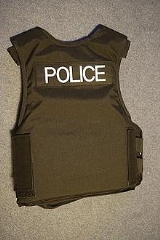
Stab vest
Encyclopedia

Torso
Trunk or torso is an anatomical term for the central part of the many animal bodies from which extend the neck and limbs. The trunk includes the thorax and abdomen.-Major organs:...
, back
Human back
The human back is the large posterior area of the human body, rising from the top of the buttocks to the back of the neck and the shoulders. It is the surface opposite to the chest, its height being defined by the vertebral column and its breadth being supported by the ribcage and shoulders...
and sides. Stab vests are different from bulletproof vests, most of which offer protection against firearms but afford little against stabbing with sharp-tipped objects such as knives; most stab vests afford less protection against bullets, particularly those of high caliber, but are designed to prevent serious injury by prohibiting knife penetration beyond a few millimeters.
While frequently used when referring to body armor, the colloquial terms “bulletproof” and “stab proof” are misleading. No armor will defeat all ballistic or hand-wielded threats of any geometry, mass and composition at any velocity. Modern body armor vests used by military, prison and police officials are tested to various standards, which establish minimum performance ratings against specific threats. Performance ratings do not extend beyond the specific threats and conditions defined within the parameters of the test standard.
In the US, the National Institute of Justice (NIJ) has established a stab resistant body armor test standard (NIJ STD 0115.00), which defines two threat types: spike and edged blade.
Manufacturers of body armor can voluntarily submit armor models for compliance testing through the National Law Enforcement and Corrections Technology Center in Rockville, MD. Through the program, manufacturers certify that their armor will defeat the specified threat at one of three threat levels. Threat levels 1, 2 and 3 are based on impact energies of 24-, 33- and 43-joules respectively. In the US armor can be certified to protect against spikes, edged blades or both. Armor certified against only spikes or only edged blades does not necessarily provide protection against the other.
The NIJ standard is based on work conducted by the Police Scientific Development Branch (PSDB) in the United Kingdom. The PSDB work studied what kind of weapons are commonly used in stabbing attacks and what levels of impact energy fit young men are capable of generating during an attack. The study resulted in minimum performance ratings for armor used in the UK, as defined under PSDB publication 6/99. The PSDB standard was replaced in 2007 with the current Home Office Scientific Development Branch (HOSDB) publication No. 39/07/C, which governs stab resistant body armor performance in the UK.
The US and UK standards are nearly identical however in the UK there are no standalone ratings for spike resistance. For stab resistant armor to carry a spike resistance (SP) rating in the UK, it must first pass minimum knife resistance (KR) performance tests.
Concealable Stab-Protective Body Armor
The Concealable Stab-Protective Body Armor (CSPBA) is a stab vest, worn by United States Army personnel performing law enforcement operations, including confinement of enemy prisoners of war and overseeing civilian internees, for protection against homemade weapons and handguns. The CSPBA provides soft armor protection to the torso against a 9mm, full metal jacket 124-grain bullet and meets the California Ice Pick standard for protection against other crude stab/slash weapons.External links
- Protect Yourself - Stab Vest information and sales
- New Zealand Herald - Councils fight violence with stab vests
- Image of a stab vest to be worn under outer clothing
- National Institute of Justice Standard 0115.00, Stab Resistance of Personal Body Armor
- Stab-Resistant Armor
- HOSDB Body Armour Standards for UK Police (2007)Part 3: Knife and Spike Resistance
This article incorporates work from https://peosoldier.army.mil/newpeo/Equipment/Temp.asp?id=SPE_CSPBA, which is in the public domain
Public domain
Works are in the public domain if the intellectual property rights have expired, if the intellectual property rights are forfeited, or if they are not covered by intellectual property rights at all...
as it is a work of the United States Military.

